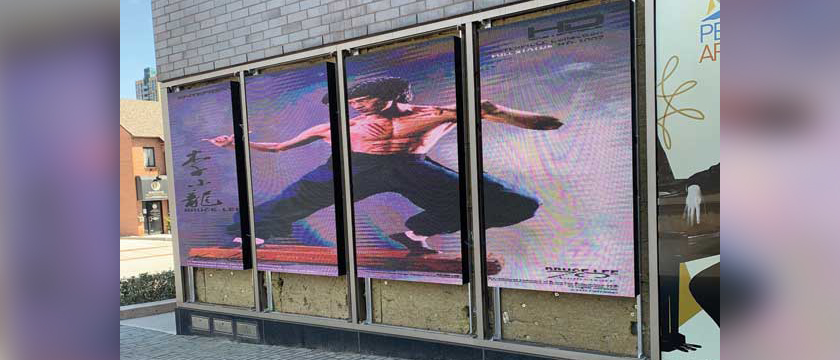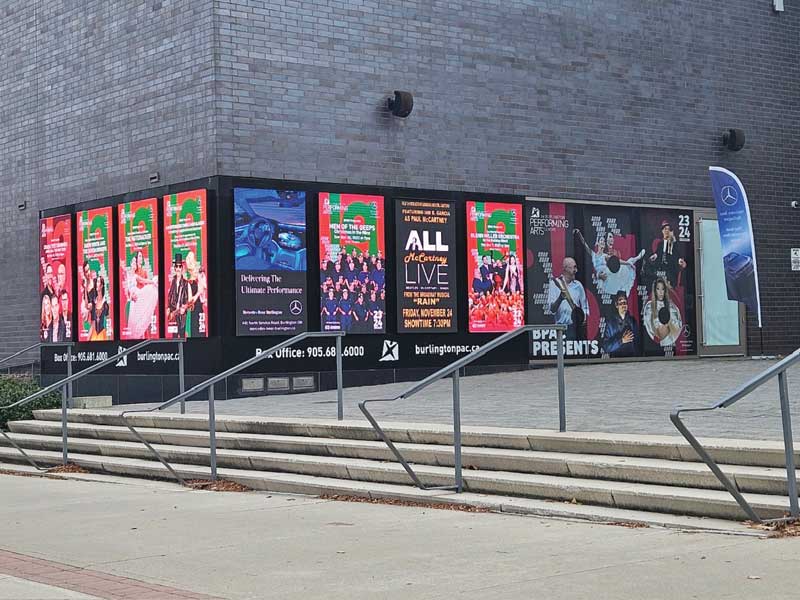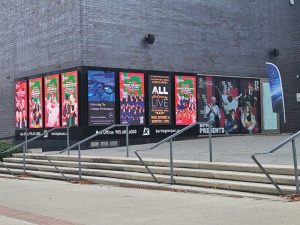A theatrical presentation
by carly_mchugh | 11 February 2024 5:15 pm
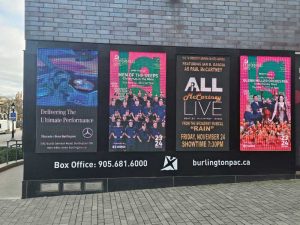 [1]
[1]LED Solutions recently replaced the aging poster boards at the Burlington Performing Arts Centre (BPAC) with a digital solution. Photos courtesy LED Solutions
By Carly McHugh
A few years ago, LED Solutions of Hamilton showcased their talent with digital displays by creating their largest video board installation project, at local Theatre Aquarius. Spanning 0.9 x 18.2 m (3 x 60 ft), it wrapped around the marquee, and informed theatregoers and passersby which productions they could delight in that season. Indeed, the goal of the signage was to draw attention, and based on the interest that followed, it played its part quite well.
Shortly after the project’s completion, LED Solutions received a call from the Burlington Performing Arts Centre (BPAC). The fellow theatre liked the work the shop had done in the neighbouring city and wanted to have their own poster boards replaced with a digital solution. The glass doors which protected their seasonal posters were getting old, and one of them had broken, so BPAC decided it was time for a change.
After the initial call, communications went quiet for a while—until the theatre’s new operations manager reached out in March 2022. From there, the process moved fairly quickly, with the decision to remove the glass doors, access the shell of the building, and insert the new video boards. From there, LED Solutions would set them up on a network, close up the wall, and waterproof the section of the building with new cladding.
The project began with site visits, as well as quoting and determining the appropriate budget. At first, BPAC was not sure if they wanted to do one or both sides of the poster wall, so the shop provided quotes for each option. Eventually, the team determined the most beneficial and cost-effective solution was to finish the entire area. However, before they moved on to the next step, BPAC wanted to see a project LED Solutions had recently completed, which brought them to a pylon sign at an Access Storage facility in nearby Oakville. Then, the operations manager asked to see a piece of equipment from the project and hold it in their hands. The shop provided them with a sample module, so they could see the construction quality of the boards. Once BPAC had seen how the project would come together, it was time to proceed with the permit.
The theatre handled this portion of the project, as they had a close working relationship with the City of Burlington and were confident they could secure it quickly. As a result, it was never required to go to variance, which helped ensure a smooth transition. When the team had the permit in hand, they were ready to order the materials. The vision for the project was eight 1.5- x 2.1-m (5- x 7-ft), single-sided video boards with 6.6-mm (0.2-in.) resolution. They would be kitty-cornered along the wall by the building’s main entrance, with four on each side.
LED Solutions worked with the theatre’s electrician to make sure there was an appropriate power load to each board back to the breaker. After some tweaking, the electrical system was finalized, and the team met with the project’s integration technician. A contact of LED Solutions through fellow shop Media Resources Inc., his role was to get the signage networked into the building’s system and educate the client on its integration and operation. While this portion of the project took place at the theatre, the video boards were also being fabricated back at the shop.
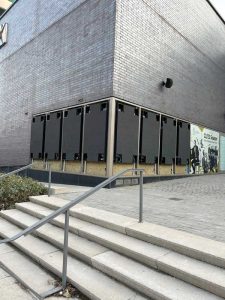 [2]
[2]The shop removed the glass doors to access the shell of the building and insert the new video boards. From there, they set them up on a network, closed up the wall, and waterproofed the system with new cladding.
Once the boards were ready, LED Solutions prepared for their installation by removing the eight heavy glass doors which covered the old poster boards. Since the client had no further use for them, they were brought to Hamilton for storage and potential reuse.
With the doors removed, the team found themselves inside the building’s facade, in a 127-mm (5-in.) deep box with an aluminum frame and fibreglass insulation. However, at this stage, they were presented with a challenge. On the other side of the wall was a dance recital hall, lined with soundproof material. Under no circumstances could they drill through to the other side to connect the signage system. All they had access to was an external power cable, leading into the building.
To overcome this obstacle, LED Solutions needed to build a structure to hold the boards in place. They fabricated an aluminum skeleton, so the boards could be inserted and attached, then plugged into the power source. Afterwards, they daisy-chained a data cable from one board to the next. When all the boards were hooked up, the integration technician returned to sit down with the client, to get them networked and communicating with each other. Since there was no line of sight to the Wi-Fi antennas or the operations manager’s office, it was determined the best course of action was placing a subscriber identity module (SIM) card in the controller and using a 4G, cloud-based cellular network. With this technology, the screens could be changed from anywhere, inside or outside the building.
Once the screens were networked, the electrician completed the wiring and tested all the power loads. Then, the Electrical Safety Authority (ESA) performed an on-site inspection, to ensure and sign off that all the work was compliant. After both these steps were finished, it was time to close up the display.
One major factor for the team to consider when closing up the wall was ventilation. The boxes were only 127-mm deep, but the video boards were 152.4-mm (6-in.) deep. They would be slightly sticking out in the final product—which would not be an issue when the wall was closed up—but the back of each board would face the back of the wall. If they did not have the proper ventilation to breathe, they would certainly fail. Therefore, LED Solutions left a small gap and included air vents along the sides of the video boards. The left and right side of each board was clad with black, perforated metal for airflow, while the tops, bottoms, and remaining spaces were covered with matte black aluminum composite material (ACM).
Finally, with everything closed up, LED Solutions monitored the weather for rain, and checked in continuously with BPAC to make sure the installation was watertight. They credited the success of the project to assessing any potential issues and taking any challenges into consideration early on in the process. The screens have been successfully broadcasting the theatre’s coming attractions since June 2023.
The city’s affiliated sign shop later added vinyl details to the wall, including the box office number, website, and BPAC logo.
- [Image]: https://www.signmedia.ca/wp-content/uploads/2024/03/20231120_125722.jpg
- [Image]: https://www.signmedia.ca/wp-content/uploads/2024/03/IMG_0677.jpg
Source URL: https://www.signmedia.ca/a-theatrical-presentation/
